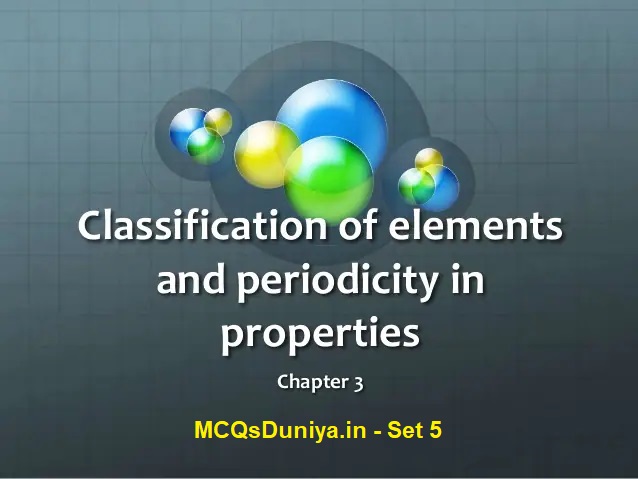CBSE Class 11 Chemistry Chapter 3 Classification of Elements and Periodicity in Properties Multiple Choice Questions with Answers. MCQ Questions Class 11 Chemistry Classification of Elements and Periodicity in Properties with Answers was Prepared Based on Latest Exam Pattern. Students can solve NCERT Class 11 Chemistry Classification of Elements and Periodicity in Properties MCQs with Answers to know their preparation level.
Students who are searching for NCERT MCQ Questions for Class 11 Chemistry Classification of Elements and Periodicity in Properties with Answers are compiled here to get good practice on all fundamentals. Know your preparation level on MCQ Questions for Class 11 Chemistry with Answers. You can also verify your answers from our provided MCQ Class 11 Chemistry Classification of Elements and Periodicity in Properties with Answers. So, ace up your preparation with MCQ of Chapter 3 Chemistry Objective Questions.
MCQ Questions Class 11 Chemistry Classification of Elements and Periodicity in Properties with Answers - Set - 5
Question 1:
The general outer electronic configuration of transition elements is
(a) ns²nd1-10
(b) ns²np1(n – 1)d1-10
(c) ns²np6(n – 1)d1-10
(d) ns0-2 (n – 1)d1-10
Correct Answer – (D)
Question 2 :
If the ionic radii of K+ and F– are about 1.34 Å each, then the expected values of atomic radii of K and F should be respectively
(a) 2.31 and.0.64 Å
(b) 2.31 and 1.34 Å
(c) 0.64 and 2.31 Å
(d) 1.34 and 1,34 Å
Correct Answer – (A)
Question 3 :
Which of the following represents most electropositive element?
(a) [He]2s1
(b) [He]2s²
(c) [Xe]6s1
(d) [Xe]6s²
Correct Answer – (C)
Question 4 :
Which of the following processes involves absorption of energy?
(a) Cl + e– → Cl–
(b) O– + e– → O2-
(c) O + e– → O–
(d) s + e– → s–
Correct Answer – (B)
Question 5 :
Which of the following is the smallest cation?
(a) Na+
(b) Mg2+
(c) Ca2+
(d) Al3+
Correct Answer – (D)
MCQ Questions Class 11 Chemistry Classification of Elements and Periodicity in Properties with Answers
Question 6 :
Total number of elements present in the 3rd period is
(a) 6
(b) 32
(c) 18
(d) 8
Correct Answer – (D)
Question 7 :
An element with atomic number 106 has been discovereq recently. Which of the following electronic configuration will it have
(a) [Rn]5f146d47s²
(b) [Rn]5f146d57s1
(c) [Rn]5f14 6d67s0
(d) 5f146d7s²7p³
Correct Answer – (A)
Question 8 :
In which of the following compounds does che ratio of the anion si/e to cation size has the lowest value?
(a) CsI
(b) Li I
(c) LiF
(d) CsF
Correct Answer – (D)
Question 9 :
The first ionisation energy for Li is 5.4 eV and electron affinity of Cl is 3.61 eV. The ∆H (in k] mol-1) for the reaction.
Li (g) + Cl (g) → Li+ (g) + Cl– (g) if the resultant ions do not combine with each other is [1eV = 1.6 × 10-19 J]
(a) 70
(b) 100
(c) 170
(d) 270
Correct Answer – (C)
Question 10 :
Element with atomic number 56 belongs to which block?
(a) s
(b) p
(c) d
(d) f
Correct Answer – (A)
- NCERT Solutions Class 11 Chemistry Chapter 1 : Some Basic Concepts of Chemistry
- NCERT Solutions Class 11 Chemistry Chapter 2 : Structure Of The Atom
- NCERT Solutions Class 11 Chemistry Chapter 3 : Classification of Elements and Periodicity in Properties
- NCERT Solutions Class 11 Chemistry Chapter 4 : Chemical Bonding and Molecular Structure
- NCERT Solutions Class 11 Chemistry Chapter 5 : States of Matter
- NCERT Solutions Class 11 Chemistry Chapter 6 : Thermodynamics
- NCERT Solutions Class 11 Chemistry Chapter 7 : Equilibrium
- NCERT Solutions Class 11 Chemistry Chapter 8 : Redox Reactions
- NCERT Solutions Class 11 Chemistry Chapter 9 : Hydrogen
- NCERT Solutions Class 11 Chemistry Chapter 10 : The s-Block Elements
- NCERT Solutions Class 11 Chemistry Chapter 11 : The p-Block Elements
- NCERT Solutions Class 11 Chemistry Chapter 12 : Organic Chemistry: Some Basic Principles and Techniques
- NCERT Solutions Class 11 Chemistry Chapter 13 : Hydrocarbons
- NCERT Solutions Class 11 Chemistry Chapter 14 : Environmental Chemistry




